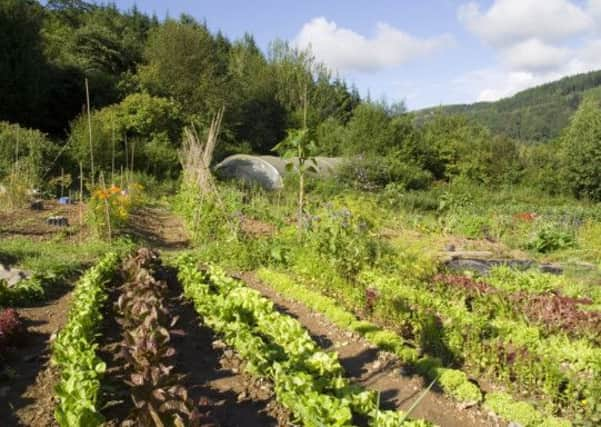How to make money from gardening


But for keen gardeners what better way to start 2014 than by looking at turning a hobby into a business and making some money out of that glut of fruit and vegetables?
A new book called Gardening for Profit, From Home Plot to Market Garden provides a step-by-step guide for anyone interested in selling their home-grown produce on a full or part-time basis.
Advertisement
Hide AdAdvertisement
Hide AdFrom finding land and deciding what crops to grow to marketing your produce and managing your accounts, the book looks at all the aspects that need to be considered when starting your own market garden business.
Author Kate Collyns writes from experience, having given up a career in magazine publishing to start Grown Green @ Hartley Farm three years ago.
Her love of gardening came from her grandmother who grew her own vegetables. “I can remember the excitement of digging up potatoes and those creamy dirty gems gradually appearing, and how you always had to dig again, just in case you’d missed some,” she says. “I can also remember how sweet the peas were straight from the pods – delicious!”
This interest in home-grown food continued into adulthood and even when Collyns lived in a rented flat, she would grow food in pots. She made the transition into growing food commercially after training as an apprentice at Purton House Organics under the Soil Association Future Growers scheme.
“The difference between growing commercially and keeping a few pots is very large,” she says. “It’s not necessarily the actual skills involved – although larger scales do require you to learn a few extra things of course, such as tractor-driving, planting and weeding in set rows, harvesting techniques in bulk and so on – rather the mindset too.
“You and your friends may know that these lovely things you’re producing taste delicious and are the product of a lot of hard work in your garden, but when you have to sell your produce, you have to persuade them (the customer) of the value of it, rather than assuming they already know. This could be via taste tests, or explaining the story behind the produce and how it’s grown.
“That’s probably one of the hardest things about the change. Not only do you work very hard in all weathers for not very much money, but you also have to justify why you think someone should pay you for your produce at all.”
Before you get to this stage, though, you first need the land and equipment to grow your food and the money to fund it all. In the book, Collyns looks at different options for finding land which can range from buying it yourself to getting involved in a community project.
Advertisement
Hide AdAdvertisement
Hide AdShe also lists the essential equipment needed to grow food commercially, including the seeds themselves to gardening tools, pest-proof fencing and greenhouses.
And she gives advice on how to raise money for your project be it in the form of a bank loan, from a trust or private funder.
Collyns started from scratch renting two acres of land on a farm in Wiltshire and estimates she paid £10,000 over the first two years, including the cost of two new polytunnels and equipment such as rotovators, nets, mesh and trays as well as making one homemade module tunnel.
She began selling produce in the spring of 2011, after starting to put up her polytunnels the previous winter. However, she says: “A full season is needed before money really starts coming in, and it may take a few years to establish a successful rotation while getting to know your soil.”
Even when the money does start to come in, Collyns says it is not a job for someone looking to make their fortune. “No-one goes into growing veg in order to be a millionaire. However, if you enjoy what you do, and it gives you a sense of purpose, then as long as you make enough money to live off, you can’t ask more than that. Plus if I was a millionaire, I would still grow veg.”
She adds: “The benefits include the knowledge that what you’re doing is an essential part of life. In some previous jobs, I’ve wondered to myself ‘What’s the point of this?’ Growing fresh and healthy produce for local people to enjoy is a great feeling, especially when customers and chefs let you know how much they appreciate it. Because I grow my produce to organic standards, I also know that I’m taking care of the soil, where all life starts after all, and providing a haven for biodiversity – all within a workable business.”
Her least profitable crop so far has been aubergines while her most successful crops have been chard, kale and leeks because they are low-maintenance and grow outside.
She also recommends growing fresh leafy herbs and salads which can be grown to meet local demand and marketed as being sustainably and locally produced.
Advertisement
Hide AdAdvertisement
Hide AdPossible ways of selling your produce include via a market stall, veg van or box scheme. Alternatively you can sell wholesale to shops and farm shops, cafes, pubs and restaurants.
Before plunging into the market garden business, though, Collyns says gardeners should consider how much they enjoy growing food. “Do you really enjoy growing, even picking, in freezing rain or boiling polytunnel temperatures? You’ll need to be able to convey your passion to your customers. If you don’t believe in what you’re doing, neither will they.”
If the answer is yes, then she recommends giving it a try. “I’m convinced that local food is going to play an increasingly important role in the future, so join the fun.”
• Gardening for Profit, From Home Plot to Market Garden by Kate Collyns is published by Green Books and costs £7.99.